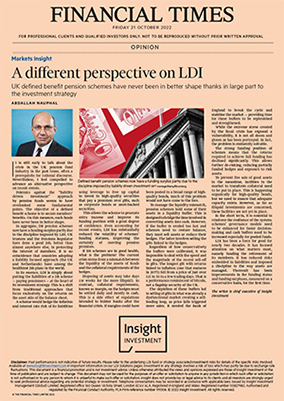OP-ED FOR THE FT MARKETS INSIGHT COLUMN
By Abdallah Nauphal, chief executive of Insight Investment
21 October, 2022
It is still early to talk about the crisis in the UK pension fund industry in the past tense, often a prerequisite for rational discourse. Nevertheless, I feel compelled to advance an alternative perspective on recent events.
Polemics against the “liability driven investment” approach by pension funds seems to have overlooked some fundamental points. The objective of a defined benefit scheme is to secure members’ benefits. On this measure, such funds have never been in better shape. In aggregate, DB pension schemes now have a funding surplus partly due to the discipline imposed by LDI.
UK trustees and the Pensions Regulator have done a good job, better than almost anywhere else, in protecting the interest of members. It is no coincidence that countries adopting a liability focused approach (the UK and Netherlands) have among the healthiest DB plans in the world.
In its essence, LDI is simply about putting the liabilities of a DB scheme — paying pensioners — at the heart of its investment strategy. This is a shift from traditional approaches that focus exclusively on the returns on the asset side of the balance sheet.
A scheme would hedge the inflation and interest rate risk of its liabilities using leverage to free up capital to invest in high-quality securities that pay a premium over gilts, such as corporate bonds or asset-backed securities. This allows the scheme to generate extra income and improve its funding position with a great degree of confidence.
Even accounting for recent events, LDI has substantially reduced the volatility of schemes’ funding statuses, improving the certainty of meeting pension promises. If DB schemes are in good health, what is the problem?
The current crisis stems from a mismatch between the liquidity of the assets of funds and the collateral requirements of the hedges. Disposing of assets may take days (or weeks for the more illiquid). In contrast, collateral requirements, known as margin, on the hedges must be settled daily and mostly in cash. This is a side effect of regulations intended to bolster banks after the financial crisis. If margins could have been posted in a broad range of high-quality bonds, much of this problem would not have come to the fore.
To manage the liquidity mismatch, pension schemes hold some of their assets in a liquidity buffer. This is designed to bridge the time involved in converting assets into cash. However, if the buffer is eroded too fast and schemes need to restore balance, they must sell assets or reduce their hedges. The latter involves selling the gilts linked to the hedges.
Regardless of how conservatively the buffers were calibrated, it was impossible to deal with the speed and the magnitude of the recent sell-off in gilts. The longest gilt with returns linked to inflation (one that matures in 2073) fell from a price of just over 115 to 50 in a few trading days. That is a performance reminiscent of bitcoin, not a flagship security of the UK.
The depletion of these buffers led to selling of gilts in what was already a dysfunctional market creating a self-feeding loop, as price falls triggered more sales. It needed the Bank of England to break the cycle and stabilise the market — providing time for these buffers to be replenished and strengthened. While the extreme stress created by the fiscal crisis has exposed a vulnerability, it is not all doom and gloom as has been portrayed. In fact, the problem is eminently solvable.
The strong funding position of schemes means that the returns required to achieve full funding has declined significantly. This allows further de-risking, reducing partially funded hedges and exposure to risk assets. To prevent fire sale of good assets in the meantime, facilities in the market to transform collateral need to be put in place. This is happening organically for high-quality bonds, but we need to ensure that adequate capacity exists. However, as far as illiquid investments are concerned, these facilities are not yet in place.
In the short term, it is essential to reinforce the resilience of the system: schemes’ governance models need to be enhanced for faster decision-making and cash buffers need to be increased especially for pooled funds. LDI has been a force for good for nearly two decades. It has focused attention on what matters most, namely funding the retirement of its members. It has reduced risks embedded in liabilities and imposed a discipline to the way assets are managed. The result has been improvements in the funding status and funding surpluses, measured on a conservative basis, for the first time.
Click here to download the PDF version
 United Kingdom
United Kingdom





















